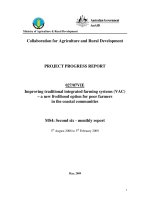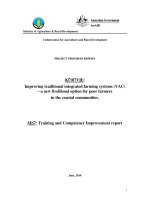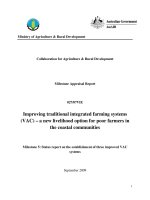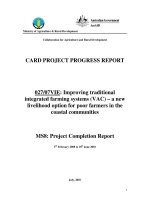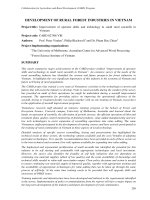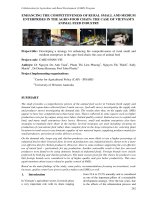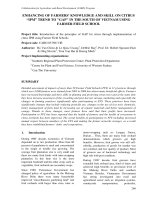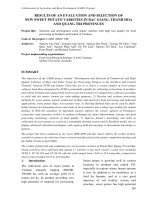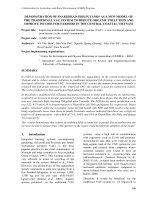Báo cáo nghiên cứu nông nghiệp " Improving traditional integrated farming systems (VAC) - a new livelihood option for poor farmers in the coastal communities " pptx
Bạn đang xem bản rút gọn của tài liệu. Xem và tải ngay bản đầy đủ của tài liệu tại đây (15.48 MB, 8 trang )
Collaboration for Agricul
ture and Rural Development
(CARD)
Program
306
DEMONSTRATION OF SNAKEHEAD FISH IN TANKS AS A NEW MODEL OF
THE TRADITIONAL VAC SYSTEM TO REDUCE ORGANIC POLLUTION AND
IMPROVE INCOME FOR FARMERS IN THE CENTRAL COASTAL VIE
TNAM
Project title:
Improving traditional integrated farming systems (VAC)
-
a new livelihood option for
poor farmers in the coastal communities
Project c
ode
:
CARD
027/07 VIE
Author(s):
Võ V
ăn B
ình
1
, Đào Văn Phú
1
, Nguy
ễ
n Quang Chương
1
, Mai Văn Tài
1
,
Ass
oc. Prof
.
Ravi Fotedar
2
, Jane Fewtrell
2
Project Implementing organisations:
1
Centre for Environment and Disease Monitoring in Aquaculture (CEDMA)
–
RIA1
2
Agriculture and Environment
-
Division of Science and Engineering
-
Curtin
University of Technology
,
Australia
SUMMARY
In order to overcome the limitation of land available for aquaculture in the central costal region of
Vietnam and to reduce organic pollution in traditional integrated fish farming, a new method was
developed called the ‘improved VAC’
In traditional VAC systems the manure from farm animals is
released into fish ponds whereas in the ‘Improved VAC’ the manure is used for earthworm culture.
The worm production is then used to feed high value fish species in tanks.
In this project snakehead
fish (Channa maculatus) cultured in tanks and fed partly on earthworms,
resulted in an increase in income generation for farmers. The results have shown that the fish growth
rate was relatively high, reaching 700 g/fish after 5 months. The FCR for the en
tire production cycle
was 5.22, 4.75 and 6.14 in demonstrations in Thanh Hoa, Ha Tinh and Quang Tri, respectively. Water
quality remained within the acceptable range for fish health with NH3 and NO2 levels in the tanks
being significantly lower than those
in ponds. Economic analysis indicated that there was a high net
profit in all demonstrations with a ROI of 71%, 104% and 41% in Thanh Hoa, Ha Tinh, and Quang
Tri respectively.
The results demonstrate that culture of snakehead fish in tanks fed a partia
l diet of earthworms can
increase income to farmers thus other farmers in the region could benefit from adoption of the model.
1.
Introduction
Integrated farming systems encompassing
gardening, fish pond and livestock pen (under
Vietnamese acronym VAC
) is the most
popular practice in the rural communities of
Vietnam and other countries in Asia including
China (Vincke, 1997). This farming model is
very efficient in terms of recycling of the
materials in the system (Bilard et al., 1990).
However, the pro
ductivity of the aquaculture
(pond) component is quite low ranging from a
few hundred kilograms to an average 1,500
-
1,700 kg per ha per year (0,015
-
0,017
kg/m2.year) (Kumar et.al, 2003). Aquatic
species produced in the traditional VAC
systems carry a hig
h risk of contamination
with organisms such as E.coli and parasites.
Acinetobacter spp. that were exposed to the
high organic load of the VAC system for two
months and isolated from composite water
-
sediment samples were found to have an
increased resistanc
e to oxytetracycline and
sulfamethoxazole (Andreas Petersen et al.,
2002). E.coli , isolated from mothers involved
in integrated fish farming were found to have
increased antibiotic resistance compared to
those isolated from mothers who were not (
Kalter
, 2009).
Therefore, it would be beneficial for the
traditional VAC system to be improved to
CARD 027/07 VIE
–
Demonstration of improved VAC model in Central Vietnam
307
enable increased productivity and reduce
potential organic pollution. In the Improved
VAC, manures from husbandry or by
-
product
of horticulture are used for the c
ulture of
earthworms. The earthworms produced are
then used as food for high value fish species
cultured in tanks and the faeces of the worm
is used as fertilizer.
This article presents the results from
demonstration implementation of the Improved
VAC f
or the project CARD 027/07VIE. It
focuses on the snakehead cultured in tanks fed
with trash fish and earthworms. Examination
of fish growth rate, the water quality in tanks
and economic analysis of the demonstrations
are included.
2.
Materials
and methods
The demonstrations of the Improved VAC
were implemented in three middle provinces of
the country: Quang Xuong
-
Thanh Hoa,
Thach Ha
-
Ha Tinh and Trieu Phong
-
Quang
Tri. These sites are representative for three
socio
-
eco
-
systems. The first site, Thanh Ho
a,
is representative of a small household scale
(small garden and ponds with no artificial
aeration). The second site is for households
who have a higher standard of husbandry and
horticulture but no pond. The third site was in
Quang Tri and is representa
tive of households
with a large pond/s but poor water quality, and
basic horticulture and husbandry practices.
The Improved VAC system includes 30
–
40m3 (height of 60
–
80 cm) of water in
concrete tanks or pond (100
–
300 m2), a
livestock pen with an are
a of 50
-
60m2 which
can produce manure for cultivation of earth
worms and a vegetable garden (Figure 1). The
fish tanks were surrounded with synthetic
polymer nets up to 2 m in height to prevent the
fish “jumping” out of the tanks when it rains.
Indicators
to assess efficiency of an Improved
VAC include culture water quality and profit
generation compared to a traditional VAC.
Water quality is evaluated by using parameters
such as temperature, DO, NH3, NO2, NO3,
BOD, H2S. In traditional VAC these
parameters
are usually at the high end of
acceptable values in the range for growth for
aquatic animals.
Fig 1.
Flow of materials in an Improved VAC:
Manures from animal husbandry are not
directly released into fish ponds. Instead
manure is used for e
arthworm culture.
During the production cycles, samples were
collected for water quality analyses. The
sampling was conducted in different positions
in tanks, that is, close to the water inlet and
outlet and in the centre part of the tank. In the
ponds t
wo samples were taken, that is, near to
the pump and in the centre of the pond.
Samples were then tested for NH
3
, NO
2
, pH,
DO and hardness by using test kits and
laboratory analysis. The results were
interpreted in comparison with the traditional
VAC and i
n accordance with the acceptable
range for aquatic animals outlined in the
National Standard for Water Quality (TCVN,
1995; 2000)
Snakehead (Channa maculatus) was stocked at
density of 10 fish/m². The water level in tanks
was maintained at 10
–
40 cm in d
epth,
depending on the size of fish. The system
pump was switched on for 1 hour, twice a day.
A partial water change was performed on the
tanks after every four days of culture.
Small snakehead were fed a diet that consisted
mainly of earthworms, while l
arger fish were
fed a diet that consisted of up to 70% trash
fish. To meet the system’s quantity
requirements, earthworm cultures were
initiated 1 month prior to stocking the system
with fish.
Garden (mainly
vegetables)
Pum
Manures for husbandry
or bypr
oduct of
horticulture
Cattle/pig/chicken
shed (manures
released)
Earth worm to culture
Semi
-
bio
filter
Fish pond
(or well to get
water)
Concret
e tanks
20m
2
Water circulated
after treated
Earthworm shed
(12
–
30 m
2
)
Võ V
ăn B
ình,
Đào Văn Phú, Nguy
ễ
n Quang Chương, Mai Văn Tài,
Ravi Fotedar &
Jane Fewtrell
308
Economic analysis of the Improved VAC was
implemented by value
estimation of input
(consisting of tanks depreciation, fingerlings,
feed), operation cost (pumping and labor
costs), and the value of output presented by
total production (from selling in markets, for
family or as gifts for relatives) multiplied by
the pr
ice at market.
3.
Results and discussions
3.1
Fish growth rate
In general, snakehead cultured in tanks in the
Improved VAC have grown fast, reaching 700
g/fish (approximately 40.5 cm in length) from
the initial size of 12 g (10 cm in length) after
about
5 months. Fingerlings fed by ground
trash fish grew at the same rate as fingerlings
fed a combination of trash fish and earthworm
(with ratio of 50:50). However, the condition
factor K (K = W*100/L3) of the fish fed the
combined feed was higher than the fi
sh fed on
trash fish only (1.20 compared to 1.12). This
indicates that earthworms are suitable food for
snakehead.
Food conversion rate (FCR) was calculated for
the whole culture period in the three
demonstrations in Thanh Hoa, Ha Tinh and
Quang Tri. Thes
e were 5.22, 4.75 and 6.14
respectively. In the beginning of the
production cycle, that is from fingerling to 300
g/fish, the FCRs for the combination feed of
trash fish and earthworm (50:50) were 3.13;
3.66 and 4.11, respectively.
Interestingly, in Ha Tin
h the Improved VAC
system was managed by well educated persons
(both husband and wife were master and
bachelor degrees) and the survival rate in this
province was higher (97%) than in Thanh Hoa
(92%) and Quang Binh (87%) where system
managers had less for
mal education. This
suggests that system knowledge and
understanding could be an important factor in
the success of the operation.
3.2
Water quality in tanks and ponds
The results clearly show that the semi
-
bio filter
operated efficiently, resultin
g in lower levels
of NO
2
and NH
3
in tanks than those in ponds
(Figure 3). NO
2
was lower than 0.1 mg/l in all
demonstration sites; which is within the
acceptable range for normal growth rate of
aquatic species, including snakehead fish.
In Quang Tri, for i
nstances, the level of NH
4
and NO
2
were low in tanks while in ponds they
were sometimes higher than the acceptable
limit The value of NH
4
and NO
2
fluctuated
between 0.36
–
0.66 mg/l and 0.004
–
0.03
mg/l, respectively (Figure 3).
Fig 2
. Growth rat
e of snakehead fish in tanks in the
Trieu Phong
–
Quang Tri Improved VAC
demonstrations
Võ V
ăn B
ình,
Đào Văn Phú, Nguy
ễ
n Quang Chương, Mai Văn Tài,
Ravi Fotedar &
Jane Fewtrell
309
Fig 3.
Comparison of
total Ammonium and NO2 in ponds and in
tanks during the production cycle in the Quang Tri demonstration.
For snakehead, the concentration of dissolved
oxygen does not play such an important role as
many for other fish species due to the fact that
they p
ossess an organ for breathing air.
However, the concentration of NH
4
/NH
3
and
NO
2
are critical issues to consider because they
are toxic to fish at low concentrations. Both
trash fish and earthworms which were used to
feed the fish in these systems contain
high
protein levels which are quickly converted into
NH
4
/NH
3
and NO
2
within the system.
Therefore, levels of NH
4
/NH
3
and NO
2
must
be monitored and controlled.
The parameters which are not content nitrogen
original in production cycle are presented in
Table
1.
Table 1.
Non
-
nitrogenous water quality measured during the culture of snakehead in Trieu Phong
–
Quang Tri. (P = Pond, and T = Tank)
Water quality parameters
Sampling months
Apr
May
Jun
Jul
Aug
Sep
P
T
P
T
P
T
P
T
P
T
P
T
Temperature (°C)
25
.
6
23
.
4
32
.
1
27
.
2
33
.
7
27
.
4
33
.
0
27
.
0
32
.
1
28
.
3
31
.
0
27
.
9
pH
7.9
7.8
8.3
7.7
7.8
7.9
8.5
7.6
7.8
7.4
7.7
7.7
DO (mg/l)
5.5
4.2
4.1
3.4
4.0
4.1
3.0
3.4
3.4
4.3
4.2
4.4
dH
–
Hardness (mg/l)
6
.
8
6
.
5
8
.
0
7
.
0
7
.
8
6
.
8
7
.
3
9
.
7
7
.
6
8
.
6
8
.
3
8
.
2
These parameters we
re well within the
favorable ranges for snakehead growth.
However, it is important to monitor and
control these parameters as they (particularly
temperature and pH) influence the
concentration and availability of the
nitrogenous parameters. Values of DO an
d
hardness were low, ranging between 3.4
–
4.4
mg/l and 6.5
–
8.6 respectively.
3.3
Economic analysis
Economic analyses have shown a good profit
from all demonstrations, regardless of the fact
that, due to the time restrictions of the project,
the statist
ics on which the analyses were based
were limited to a one year production cycle.
From the results obtained from the
demonstrations, it can be seen that the
Improved VAC system has potential to
Võ V
ăn B
ình,
Đào Văn Phú, Nguy
ễ
n Quang Chương, Mai Văn Tài,
Ravi Fotedar &
Jane Fewtrell
310
financially benefit farmers using the integrated
system in Ce
ntral coastal provinces.
The results of analysis have shown that the
average return on investment (ROI) of
snakehead culture in tanks was high,
suggesting that the model can generate income
and benefit to famers. The demonstration in Ha
Tinh gave a ROI ind
ex of 104% (Table 2)
while in Thanh Hoa and Quang Tri were
lower, at 71% and 41% respectively (Table 3).
The largest proportion of expenditure was for
feed, occupying 47.1%; followed by tanks
depreciation (10.3%) and cost of the
fingerlings (8.2%). Earthwo
rms replaced a
large portion of the feed so feed costs would
have been higher using the traditional VAC.
Table 2.
Economic analysis
–
detail of input
and output for the demonstration in Th
ạ
ch Bàn
–
Th
ạ
ch Hà
–
Hà T
ĩnh
Expenditure
Value (VND)
Tank deprecia
tion (2 tanks x
20 m²)
1.000.000
Pump cost
150.000
Pumping cost (for
circulation)
400.000
Fingerlings stocked (2000
fish)
800.000
Feed (trash fish)
4.568.000
Labor cost (for 4 months)
2.780.000
Total input
9.698.000
Total output
19.851.000
Net profit
10.153.000
Return on investment (%)
104
Table 3.
Economic analyses of demonstrations in Thanh Hoa,
Ha Tinh and Quang Tri provinces
Economic parameters
Demonstration
Thanh Hóa
Hà T
ĩnh
Qu
ả
ng Tr
ị
Tanks area (m²)
18
20
20
Days of culture
147
139
158
Output (VND million)
8,095
19,851
10,368
Output (VND million)
4,766
9,698
7,334
Net profit (VND million)
3,392
10,153
3,034
Return on Investment (ROI)
0,71
1,04
0,41
3.4
Poten
tial of snakehead culture in
tanks
3.4.1
Advantages and disadvantages
There are several advantages
of culturing
snakehead in tanks:
1)
When compared to pond aquaculture,
culture of fish in tanks requires a relatively
small area, thereby most households in the
middle coastal areas can easily include
aquaculture in their integrated farming
system.
2)
Trash fish, as feed for snakehead, is readily
available in the coastal areas and it is
relatively cheap. Additionally, in the case of
limited supply of trash fish (e.g
. weather
disturbance such as a typhoon) earthworms
from the Improved VAC can be used as an
alternative feed.
3)
The culture conditions in tanks can be easily
manipulated and therefore the alteration of
cycles to suit individual situations and
changes in t
he market is possible.
4)
Aquaculture in tanks requires relatively
little water, thus, the operation cost for
CARD 027/07 VIE
–
Demonstration of improved VAC model in Central Vietnam
311
recirculation are reduced. Also, in some
areas, for example in Quang Tri, water that
meets the standard of quality for
aquaculture is scarce,
therefore effective
recirculating systems would be beneficial in
such areas.
5)
Snakehead can be stocked in tanks at high
density. For example stocking densities of
up to 50
–
70 fish/m² are possible and can
give productivity of 40
–
60 kg/m² without
cr
eating poor water quality in the system.
However, the culture in tanks also has some
disadvantages. The fish are easily harvested
which may lead to problems with theft, which
is common in rural areas. Also, the culture of
snakehead in tanks requires relati
vely
advanced technology, so farmers must be
trained so that the system operates efficiently
an
d costs are kept to a minimum.
3.4.2
Environmental aspect
a.
Within system
Snakehead are tolerant to low DO levels as
they possess air
-
breathing organs on sides
of
the head (Munshi et al., 1994). However, with
high concentration of BOD and COD as found
in ponds, the fish will be susceptible to
Epizootic Ulcerative Syndrome (G. N.
Frerichs, 1993). A properly functioning
filtration system (i.e. Improved VAC) will
ad
dress issues with dissolved organic material
in the water therefore, decreasing the
opportunity for disease to infect the culture.
Iron levels are another concern for snakehead
in tanks. Past experience and sampling has
shown that high iron levels in cultu
re water
correlated with an increase on snakehead
mortality In addition, results suggest that the
growth rate of fish and FCR has a negative
correlation with increasing iron concentration.
This was presented clearly in the Quang Tri
demonstration, where
the iron concentration
was relatively high (> 3 mg/l)and the growth
performance and survival of the fish were low
when compared to those found in the systems
in Thanh Hoa and Ha Tinh.
b.
Surrounding environment
Culturing snakehead in tanks has three major
advantages over pond aquaculture from an
environmental impact perspective;
1)
Less effluent is released into the
environment and, if release is necessary, it
is generally of a less polluting nature.
2)
Less water is required which is beneficial
in areas
of limited water supply.
3)
Less physical damage to the environment
resulting from construction.
Furthermore, culturing snakehead in tanks is
clean and is not associated with the bad odor
that can accompany animal husbandry.
3.4.3
Economic aspect
The ec
onomic efficiency of snakehead culture
in tanks is assessed based on the margin of the
production cost and production value at
market. Unlike many fish species, the price
gap of snakehead between farm gate and end
users is not very high because snakehead c
an
be transported and kept very easily without
mortality. Despite this the economic efficiency
of the culture is very high. More profit would
be possible if the farmers were to sell their
produce directly to restaurants
The economic analysis of the cultur
e of
snakehead in tanks eliminated the notion that
aquaculture is only possible in ponds. Farmers
now have evidence that they can include
aquaculture into their integrated farming
system with space of just 50 m².
4.
Conclusions and recommendation
s
1.
It ha
s been shown that snakeheads have
a high growth rate in tanks, reaching to
700 g/fish after 5 months culture.
2.
From demonstrations, it can be
concluded that the Improved VAC
system is suitable for most situations in
the central coastal area of Vietnam. It
w
ould be beneficial for this model to be
transferred to other farmers through the
extension system.
3.
Water quality parameters tested during
the culture indicated a suitable range for
growth of aquatic animals, including for
snakehead fish.
Võ V
ăn B
ình,
Đào Văn Phú, Nguy
ễ
n Quang Chương, Mai Văn Tài,
Ravi Fotedar &
Jane Fewtrell
312
Võ V
ăn B
ình,
Đào Văn Phú, Nguy
ễ
n Quang Chương, Mai Văn Tài,
Ravi Fotedar &
Jane Fewtrell
313
Reference
1.
Tiêu chu
ẩn Nh
à Nư
ớc Việt Nam năm 1995
(TCVN 5942
-
1995, TCVN 5992
-
1995, TCVN
5993
-
1995, TCVN 5994
–
1995 và TCVN
5996
–
1995) và năm 2000 (TCVN 6774:2000).
2.
Andreas Petersen,
Jens Strodl Andersen,
Tawatchai Kaewmak,
Temdoung Somsiri, và
Anders D
alsgaard,
2002.
Impact of Integrated
Fish Farming on Antimicrobial Resistance in a
Pond Environment.
Applied and Environmental
Microbiology, December 2002, p. 6036
-
6042,
Vol. 68, No. 12
3.
Billard, R.N. De Pauw, J.C. Micha, C.
Salomoni, and J. Verreth (1990).
The impact of
aquaculture in rural management. In:
Aquaculture Society. Special Publ. No. 12, N.
De Pauw and R. Billard (Eds) Bredene,
Belgium
4.
G. N. Frerichs, S. D. Millar and Supranee
Chinabut
, 1993.
Clinical response of
snakeheads (Ophicephalus striatus
) to
experimental infection with snakehead fish
rhabdovirus and snakehead cell line retrovirus
.
Published by Elsevier Science B.V.
5.
Henry D. Kalter, Robert H. Gilman, Lawrence
H. Moulton, Anna R. Cullotta, Lilia Cabrera,
AND Billie Velapatiño, 2009. Risk Fa
ctors for
Antibiotic
-
Resistant
Escherichia coli
Carriage
in Young Children in Peru: Community
-
Based
Cross
-
Sectional Prevalence Study.
Am. J. Trop.
Med. Hyg., 82(5), 2010, pp. 879
-
888.
6.
Munshi JS
,
Roy PK
,
Ghosh TK
,
Olson KR
.,
1994.
Cephalic circulation in the air
-
breathing
snakehead fish,
Channa punctata, C. gachua,
and
C. marulius (Ophiocephalidae,
Ophiocephaliformes)
. MeSH
–
Anat Rec.
Department of Zoology, Bhagalpur University,
Indi
a
7.
Vincke M. M. J., 1997. Integrated farming of
fish and livestock: Present stutus and future
development. F.A.O. Rome.
8.
Michael Poxton, 2003. Water Quality In
Aquaculture Farming Aquatic Animals and
Plants. Fishing (Ed. by John S. Lucas and Paul
C. Southgat
e), pp. 47
-
73 News Books a
blackwell Publishing company
.

